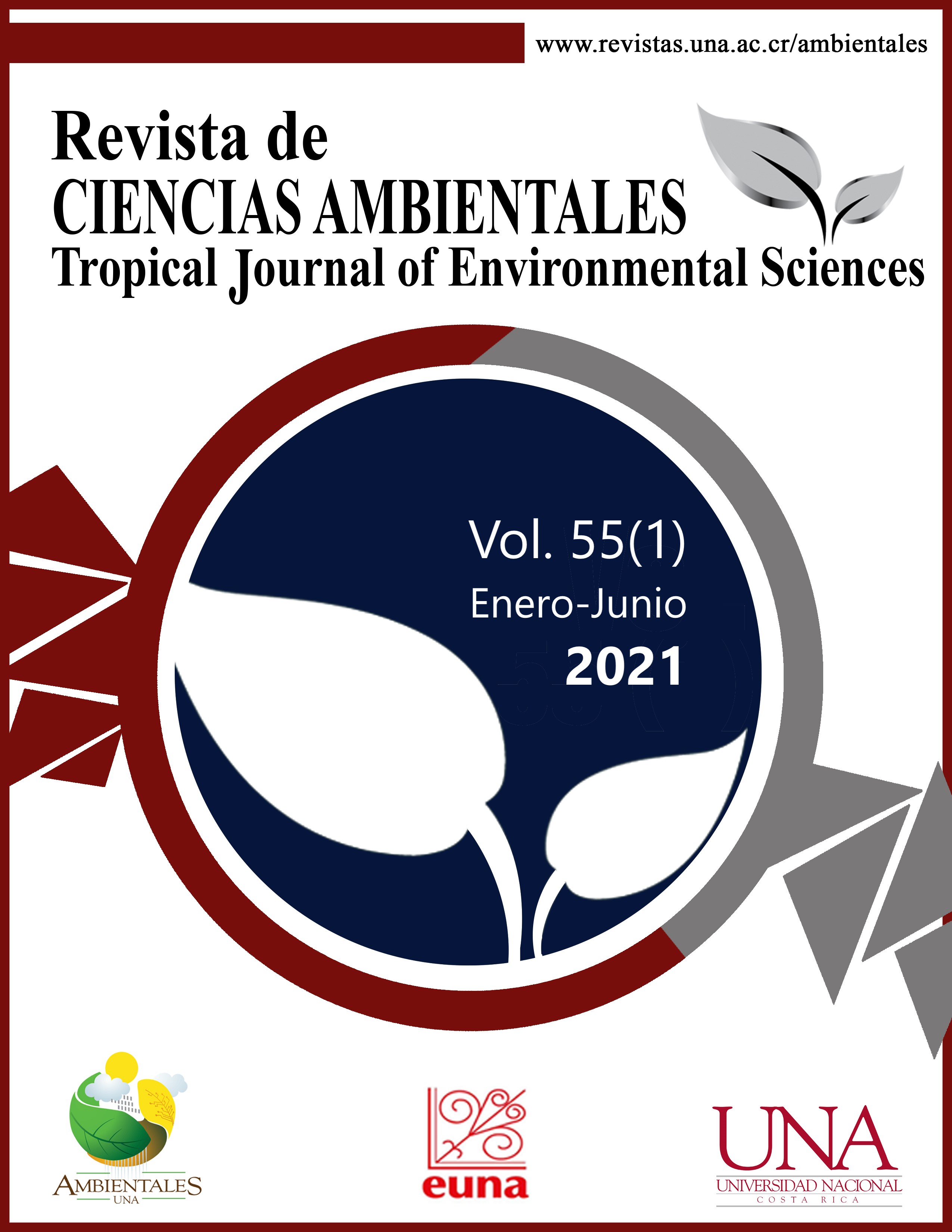Carbon accumulated in roots of plant species in silvopastoral systems in northern Colombia
DOI:
https://doi.org/10.15359/rca.55-1.3Keywords:
Fine roots; grass; length density; physicochemical properties; soil.Abstract
[Introduction]: Silvopastoral systems (SPSs) are sustainable alternatives to manage soils dedicated to livestock production, contributing to the recovery of degraded soils. [Objective]: Know the potential of carbon capture (C-capture) in fine root biomass per species and their exploration capacity in the soil between two SPSs (A1 - Megathyrsus maximum cv Mombasa associated with the shrub species, Leucaena leucocephala and Crescentia cujete; A2 - combination of A1 + tree species, Guazuma ulmifolia, Cassia grandis, and Albizia saman) and meadows without trees (A0 - M. maximum cv Mombasa), in the middle valley of the Sinú River. [Methodology]: A randomized complete block design was used with three treatments and three repetitions, in which fine root biomass (FRB, ≤ 5 mm) was determined with a cylinder of known volume and root length density (RLD) using a flatbed scanner; physicochemical properties of soil were also determined. [Results]: L. leucocephala showed high values of C accumulation in root biomass (441.5 kg C ha-1) compared to the other species evaluated. In contrast, C accumulated in grass roots was affected by the SPS complexity, reducing 59 % (A1) and 34 % (A2), with respect to A0. The highest RLD was recorded in the C. cujete and L. leucocephala species (249.7 ± 199.5 and 239.3 ± 135.02 cm cm-2, respectively). [Conclusions]: SPSs accumulate higher C in root biomass and improve the soil’s physicochemical properties.
References
Alonso, J. (2011). Los sistemas silvopastoriles y su contribución al medio ambiente. Revista Cubana de Ciencia Agrícola, 45(2), 107-115.
Baker, T. T., Conner, W. H., Lockaby, B. G., Stanturf, J. A., y Burke, M. K. (2002). Fine root productivity and dynamics on a forested floodplain in south Carolina. Soil Sci. Soc. Am. J., 66(2), 545-556. https://doi.org/10.2136/sssaj2002.0671
Barreto – Sánchez, L. H., León, P. J. (2005). Masa total y contenido de nutrientes en raíces finas de ecosistemas forestales (pinuspatulaschltdl y chamcupressuslusitanicamill y quercushumboldtiibonpl.) De piedras blancas, antioquia-colombia. Revista Facultad Nacional de Agronomía Medellín, 58(2), 2907-2929.
Bowen, G.D. (1985) Roots as a component of tree productivity. In M. G. R. Cannell, J. E. Jackson (Eds), Attributes of trees as crop plants (pp 303–315). Institute of Terrestrial Ecology Natural Environment Research Council.
Burke, M. K., y Raynal, D. J. (1994). Fine root growth phenology, production, and turnover in a northern hardwood forest ecosystem. Plant and Soil, 162(1), 135-146. https://doi.org/10.1007/BF01416099
Casals, P., Romero, J., Rusch, G. M., y Ibrahim, M. (2013). Soil organic C and nutrient contents under trees with different functional characteristics in seasonally dry tropical silvopastures. Plant and Soil, 374(1-2), 643–659. https://doi.org/10.1007/s11104-013-1884-9
Casanova - Lugo, F., Maldonado, J. C., Aldana, J. P., Sánchez, F. S., y Caamal, J. C. (2010). Acumulación de carbono en la biomasa de Leucaena leucocephala y Guazuma ulmifolia asociadas y en monocultivo. La Revista Forestal Venezolana, 54(1), 45-51.
Cajas-Giron, Y. S., Jones, M., y Sinclair, F. L. (2002). Combining tree diversity and cattle productivity on seasonally dry pastures in Columbia. International conference on responding to the increasing global demand for animal products. British Society of Animal Science.
Céspedes Flores, F. E., Fernández, J. A., Gobbi, J. A., y Bernardis, A. C. (2012). Reservorio de carbono en suelo y raíces de un pastizal y una pradera bajo pastoreo. Revista fitotecnia mexicana, 35(1), 79-86.
Contreras-Santos, J. L., J., Martínez Atencia, J., Cadena Torres, y C. K., Fallas Guzmán. (2019). Evaluación del carbono acumulado en suelo en sistemas silvopastoriles del Caribe Colombiano. Agronomía Costarricense, 44(1), 29-41. https://doi.org/10.15517/rac.v44i1.39999
Davis, M. A., Wrage, K. J., Reich, P. B., Tjoelker, M. G., Schaeffer, T., y Muermann, C. (1999). Survival, growth, and photosynthesis of tree seedlings competing with herbaceous vegetation along a water-light-nitrogen gradient. Plant Ecology, 145(2), 341-350. https://doi.org/10.1023/A:1009802211896
Organización de las Naciones Unidas para la Alimentación y la Agricultura (FAO) y Grupo Técnico intergubernamental de Suelos (GTIS). (2015). Estado Mundial del Recurso Suelo (EMRS) - Resumen Técnico. Grupo Técnico Intergubernamental del Suelo y Organización de las Naciones Unidas para la Alimentación y la Agricultura. Organización de las Naciones Unidas para la Alimentación y la Agricultura y Grupo Técnico. http://www.fao.org/3/a-i5126s.pdf
Gaitán, J. J., Penón, E. A., y Costa, M. C. (2005). Distribución de raíces finas de Eucalyptus globulus ssp. maidenii y su relación con algunas propiedades del suelo. Ciência Florestal, 15(1), 33-41. http://dx.doi.org/10.5902/198050981822
Hertel, D., Leuschner, C., y Holscher, D. (2003). Size and Structure of Fine Root Systems in Old-growth and Secondary Tropical Montane Forests (Costa Rica). Biotropica, 35(2), 143–153. https://doi.org/10.1111/j.1744-7429.2003.tb00274.x
Holdridge, L. (2000). Ecología basada en zonas de vida. Instituto Interamericano de Cooperación para la Agricultura, IICA.
International Organization for Standardization (ISO). (2016). Animal feeding stuffs: Determination of moisture and other volatile matter content (ISO 6496, 2da ed., 1-13 pp.). ISO.
Instituto Geográfico Agustín Codazzi IGAC, (2006). Métodos analíticos del laboratorio de suelo (Sexta edición). Imprenta Nacional.
Jiménez-Rodríguez, C., y Arias-Aguilar, D. (2004). Distribución de la biomasa y densidad de raíces finas en una gradiente sucesional de bosques en la Zona Norte de Costa Rica. Revista Forestal Mesoamericana Kurú, 1(2), 44-63. https://revistas.tec.ac.cr/index.php/kuru/article/view/572
Jose, S., y Dollinger, J. (2019). Silvopasture: a sustainable livestock production system. Agroforestry Systems, 93(1), 1–9. https://doi.org/10.1007/s10457-019-00366-8
Kumar, S., Udawatta, R. P., y Anderson, S. H. (2010). Root length density and carbon content of agroforestry and grass buffers under grazed pasture systems in a Hapludalf. Agroforestry Systems, 80(1), 85–96. https://doi.org/10.1007/s10457-010-9312-0
Leyva, S., Baldoquin, A. Reyes, M. (2018). Propiedades de los suelos en diferentes usos agropecuarios, Las Tunas, Cuba. Rev. Cienc. Agr., 35(1), 36-47. http://dx.doi.org/10.22267/rcia.183501.81
López-Santiago, J. G., Casanova-Lugo, F., Villanueva-López, G., Díaz-Echeverría, V. F., Solorio-Sánchez, F. J., Martínez-Zurimendi, P., … Chay-Canul, A. J. (2018). Carbon storage in a silvopastoral system compared to that in a deciduous dry forest in Michoacán, Mexico. Agroforestry Systems, 93(1), 199–211. https://doi.org/10.1007/s10457-018-0259-x
Nair, P.K.R, Kumar, B.M., y Nair, V.D. (2009). Agroforestry as a strategy for carbon sequestration. Journal of Plant Nutrition and Soil Science, 172(1), 10–23. https://doi.org/10.1002/jpln.200800030
Pérez-Ramírez, S., Ramírez, M. I., Jaramillo-López, P. F., y Bautista, F. (2013). Contenido de carbono orgánico en el suelo bajo diferentes condiciones forestales: Reserva de la biosfera mariposa monarca, México. Revista Chapingo Serie Ciencias Forestales y Del Ambiente, 19(1), 157–173. http://dx.doi.org/10.5154/r.rchscfa.2012.06.042.
Quiceno-Urbina, N.-J., Tangarife-Marín, G.-M., y Álvarez-León, R. (2016). Estimación del contenido de biomasa, fijación de carbono y servicios ambientales, en un área de bosque primario en el resguardo indígena Piapoco Chigüiro-chátare de Barrancominas, departamento del Guainía (Colombia). Luna Azul, 43, 171–202. http://dx.doi.org/10.17151/luaz.2016.43.9.
Rojas M., J., Ibrahim, M., y Andrade, H. (2009). Secuestro de carbono y uso de agua en sistemas silvopastoriles con especies maderables nativas en el trópico seco de Costa Rica. Ciencia y Tecnología Agropecuaria, 10(2), 214-223. https://doi.org/10.21930/rcta.vol10_num2_art:144
Schroth, G. (1999). A review of belowground interactions in agroforestry, focussing on mechanisms and management options. Forestry Sciences, 43, 5–34. https://doi.org/10.1023/A:1026443018920
Schroth, G., y Zech, W. (1995). Root length dynamics in agroforestry with Gliricidia sepium as compared to sole cropping in the semi-deciduous rainforest zone of West Africa. Plant and Soil, 170(2), 297–306. https://doi.org/10.1007/BF00010482
Silver, W. L., y Miya, R. K. (2001). Global patterns in root decomposition: comparisons of climate and litter quality effects. Oecologia, 129(3), 407–419. https://doi.org/10.1007/s004420100740
Sotelo, M., Suárez-Salazar, J. C., Álvarez, F., Castro Núñez, A., Calderón-Soto, V. H., Arango, J. (2017). Sistemas sostenibles de producción ganadera en el contexto amazónico — Sistemas silvopastoriles: ¿una opción viable? Publicación CIAT No. 448. Centro Internacional de Agricultura Tropical (CIAT. https://hdl.handle.net/10568/89088
Downloads
Published
How to Cite
Issue
Section
License

This work is licensed under a Creative Commons Attribution-NonCommercial-ShareAlike 4.0 International License.



















